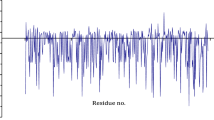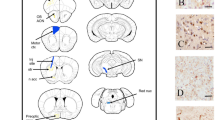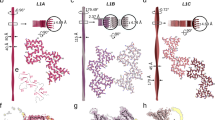Abstract
Two mutations in the gene encoding α-synuclein have been linked to early-onset Parkinson's disease1,2,3 (PD). α-Synuclein is a component of Lewy bodies, the fibrous cytoplasmic inclusions characteristic of nigral dopaminergic neurons in the PD brain4. This connection between genetics and pathology suggests that the α-synuclein mutations may promote PD pathogenesis by accelerating Lewy body formation. To test this, we studied α-synuclein folding and aggregation in vitro, in the absence of other Lewy body-associated molecules. We demonstrate here that both mutant forms of α-synuclein (A53T and A30P) are, like wild-type α-synuclein5 (WT), disordered in dilute solution. However, at higher concentrations, Lewy body-like fibrils and discrete spherical assemblies are formed; most rapidly by A53T. Thus, mutation-induced acceleration of α-synuclein fibril formation may contribute to the early onset of familial PD.
This is a preview of subscription content, access via your institution
Access options
Subscribe to this journal
Receive 12 print issues and online access
$259.00 per year
only $21.58 per issue
Buy this article
- Purchase on SpringerLink
- Instant access to full article PDF
Prices may be subject to local taxes which are calculated during checkout



Similar content being viewed by others
References
Kruger, R. et al. Ala30Pro mutation in the gene encoding α-synuclein in Parkinson's disease. Nature Genet. 18, 106–108 (1998).
Polymeropoulos, M.H. et al. Mutation in the α-synuclein gene identified in families with Parkinson's disease. Science 276, 2045–2047 (1997).
Goedert, M. Familial Parkinson's disease. The awakening of alpha-synuclein [news]. Nature 388, 232–233 ( 1997).
Spillantini, M.G. et al. α-synuclein in Lewy bodies. Nature 388, 839–840 (1997).
Weinreb, P.H., Zhen, W., Poon, A.W., Conway, K.A. & Lansbury, P.T. NACP, a protein implicated in Alzheimer's disease and learning, is natively unfolded. Biochemistry 35 , 13709–13715 (1996).
Harper, J.D. & Lansbury, P.T. Models of amyloid seeding in Alzheimer's disease and scrapie: mechanistic truths and physiological consequences of the time-dependent solubility of amyloid proteins. Ann. Rev. Biochem. 66, 385–407 ( 1997).
Jarrett, J.T. & Lansbury, P.T. Seeding "one-dimensional crystallization" of amyloid: a pathogenic mechanism in Alzheimer's disease and scrapie? Cell 73, 1055–1058 ( 1993).
Jarrett, J.T., Berger, E.P. & Lansbury, P.T. The carboxy terminus of the beta amyloid protein is critical for the seeding of amyloid formation: implications for the pathogenesis of Alzheimer's disease. Biochemistry 32, 4693-4697 (1993).
Selkoe, D. Alzheimer's disease: genotypes, phenotype, and treatments. Science 275, 630–631 ( 1997).
Lansbury, P.T. Structural Neurology: Are seeds at the root of neuronal degeneration? Neuron 19, 1151–1154 ( 1997).
Davidson, W.S., Jonas, A., Clayton, D.F. & George, J.M. Stabilization of α-synuclein secondary structure upon binding to synthetic membranes. J. Biol. Chem. 273, 9443– 9449 (1998).
Harper, J.D., Lieber, C.M. & Lansbury, P.T. Atomic force microscopic imaging of seeded fibril formation and fibril branching by the Alzheimer's disease amyloid—protein. Chem. Biol. 4, 951–959 (1997).
Harper, J.D., Wong, S.S., Lieber, C.M. & Lansbury, P.T. Observation of metastable Aß amyloid protofibrils by atomic force microscopy. Chem. Biol. 4, 119–125 ( 1997).
Hashimoto, M. et al. Human recombinant NACP/alpha-synuclein is aggregated and fibrillated in vitro: relevance for Lewy body disease. Brain Res 799, 301–306 ( 1998).
Forno, L.S. & Langston, J.W. Lewy Bodies and Aging: Relation to Alzheimer's and Parkinson's Diseases. Neurodegeneration. 2, 19–24 (1993).
Kosaka, K. & Iseki, E. Dementia with Lewy bodies. Curr. Opin. Neurol. 9, 271–275 (1996).
Spillantini, M.G., Crowther, R.A., Jakes, R., Hasegawa, M. & Goedert, M. α-Synuclein in filamentous inclusions of Lewy bodies from Parkinson's disease and dementia with Lewy bodies. Proc. Natl. Acad. Sci. USA 95, 6469 –6473 (1998).
Spillantini, M.G. et al. Filamentous alpha-synuclein inclusions link multiple system atrophy with Parkinson's disease and dementia with Lewy bodies. Neurosci. Lett. 251, 205–208 (1998).
Tu, P.-h. et al. Glial cytoplasmic inclusions in white matter oligodendrocytes of multiple system atrophy brains contain insoluble α-synuclein. Ann. Neurol. 44, 415–422 (1998).
Baba, M. et al. Aggregation of α-synuclein in Lewy bodies of sporadic Parkinson's disease and dementia with Lewy bodies. Am. J. Pathol. 152, 879–884 ( 1998).
George, J.M., Jin, H., Woods, W.S. & Clayton, D.F. Characterization of a novel protein regulated during the critical period for song learning in the zebra finch. Neuron 15, 361– 372 (1995).
Trojanowski, J. & Lee, V. Aggregation of neurofilament and alpha-synuclein proteins in Lewy bodies: implications for the pathogenesis of Parkinson disease and Lewy body dementia. Arch. Neurol. 55, 151–152 (1998).
Acknowledgements
We thank Y. Xu for doing the immunogold electron microscopy studies and C. Costello and R. Theberg for mass spectrometry. K.C. was supported by a National Science Foundation graduate fellowship.
Author information
Authors and Affiliations
Corresponding author
Rights and permissions
About this article
Cite this article
Conway, K., Harper, J. & Lansbury, P. Accelerated in vitro fibril formation by a mutant α-synuclein linked to early-onset Parkinson disease. Nat Med 4, 1318–1320 (1998). https://doi.org/10.1038/3311
Received:
Accepted:
Issue date:
DOI: https://doi.org/10.1038/3311
This article is cited by
-
Brain clearance of protein aggregates: a close-up on astrocytes
Molecular Neurodegeneration (2024)
-
Border-associated macrophages in the central nervous system
Journal of Neuroinflammation (2024)
-
Disease-specific tau filaments assemble via polymorphic intermediates
Nature (2024)
-
HTRA1 disaggregates α-synuclein amyloid fibrils and converts them into non-toxic and seeding incompetent species
Nature Communications (2024)
-
Cell-to-cell transmitted alpha-synuclein recapitulates experimental Parkinson’s disease
npj Parkinson's Disease (2024)



